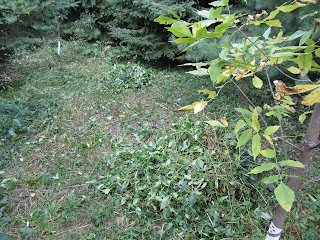Barry and Hedrik returned to continue working in the New Woods and the field
south of the pond. We decided today was one for cutting, leaving the bagging
for next Tuesday. Hedrik worked his way west toward the barn, cutting DSV
around the fir trees that separate this area from the central 'valley' of the
New Woods. He continued around and down into the large patch of burdock he was
working on earlier. Barry worked either side of the trail running south to
Green Heron Road. After break, both of us worked on the western half of the
pond's south slope and the field south of that. Hedrik also gave a much-needed
cut to an small, overlooked patch on the west end of the pond near the willow.
(We really do need to develop some code for the many different areas of the FWG!)
 |
| Hedrik's trail of destruction. |
 |
| The burdock patch... |
 |
| South slope of the pond after cutting. |
Glenda is doing some research into DSV and posted a DSV
Facts note that brought to our attention some important new findings regarding
the consequences of using DSV as mulch. We've been doing this ever since we
started cutting it, only bagging consistently in the past few weeks. Turns out
we should have been bagging all along, as DSV continues to take a toll even as
a mulch, providing leachates that discourage growth of other plants. Is there
no end to the pernicious survival strategies of this plant? Apparently not! In
a way, it's welcome news, as the issue of when to start bagging is clarified
and we can in future avoid a big problem resulting from mulch, i.e., the increased
difficulty in subsequent cuttings. We will no longer have to worry about predicting
whether mulched vines will release their seeds - the pods on cut vines dry out
faster - and inadvertently releasing them ourselves when our scythes crash into
the decaying vines as we cut renewed growth. We've always understood that this
year is experimental; here's an excellent example of new learning resulting in
revision of our techniques.



No comments:
Post a Comment